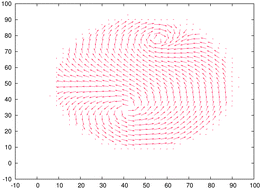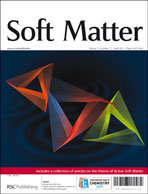Defect hydrodynamics in 2D polar active fluids†
Abstract
We present a systematic analysis of the phase diagram of a defect in an active polar fluid, found by means of Lattice Boltzmann simulations. We show that for rod-like active particles, extensile activity favours spirals and contractile activity favours asters. Polarity on the other hand introduces “self-advection terms” which can change the relative stability of defects quite dramatically. We also study the interactions of two nearby defects and uncover a novel and very rich phenomenology, which includes spontaneous rotation and oscillations for extensile activity. We discuss the possible relevance of our results to concentrated microbial suspensions and microtubular networks in vitro.

- This article is part of the themed collection: Active Soft Matter

 Please wait while we load your content...
Please wait while we load your content...